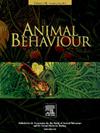Factors associated with breeding site fidelity in a nomadic shorebird with extremely low local return rates
IF 2.3
2区 生物学
Q2 BEHAVIORAL SCIENCES
引用次数: 0
Abstract
Birds that breed across multiple years can either return to the same breeding location or disperse to a different location. The propensity to return to the previous breeding site differs substantially between species, populations and individuals. In biparental socially monogamous birds (>90% of species), breeding site fidelity is typically high. Site fidelity in these species is often associated with higher breeding success and may be favoured by the benefits of remating with the same partner. In uniparental polygamous birds, which form no (or only short) pair-bonds, return rates are typically low, but factors associated with site fidelity are rarely investigated in these species. We examined factors associated with breeding site fidelity in the pectoral sandpiper, an Arctic-breeding polygynous shorebird with female-only care that is largely nomadic, with both sexes showing extremely low site fidelity between years. We individually marked 524 males and 366 females over a period of 4 years and found that the likelihood of returning to the same breeding area in the following year was higher for males (2.4%) than for females (0.5%). Breeding site fidelity of males was predicted by their siring success and tenure: those that had sired offspring with more females and had resided in the breeding area longer were more likely to return. Moreover, males that returned to the study area had higher siring success than males that had not been in the study area the previous year. Breeding site fidelity may be a beneficial strategy for individuals that are successful in a certain location, even in species that are generally nomadic.
在极低的地方返回率的游牧滨鸟繁殖地点保真度的相关因素
跨越数年繁殖的鸟类可以返回相同的繁殖地点,也可以分散到不同的地方。返回以前繁殖地的倾向在不同的物种、种群和个体之间有很大的不同。在双亲的社会一夫一妻制鸟类中(90%的物种),繁殖地点的保真度通常很高。这些物种的位点保真度通常与更高的繁殖成功率有关,并且可能受到与同一伴侣继续生活的好处的青睐。在单亲一夫多妻的鸟类中,没有(或只有短暂的)配对关系,回报率通常很低,但与位点保真度相关的因素很少在这些物种中进行研究。我们研究了与胸鹬繁殖地点保真度相关的因素,胸鹬是一种北极繁殖的一夫多妻滨鸟,雌性只照顾,主要是游牧的,两性之间的地点保真度极低。在4年的时间里,我们分别标记了524只雄性和366只雌性,发现雄性在第二年返回同一繁殖区域的可能性(2.4%)高于雌性(0.5%)。雄性的繁殖地点保真度是通过它们的繁殖成功和任期来预测的:那些与更多雌性交配并在繁殖区域居住更长时间的雄性更有可能返回。此外,返回研究区域的雄性比前一年不在研究区域的雄性有更高的繁殖成功率。繁殖地点的保真度对于在特定地点取得成功的个体来说可能是一种有益的策略,即使在通常是游牧的物种中也是如此。
本文章由计算机程序翻译,如有差异,请以英文原文为准。
求助全文
约1分钟内获得全文
求助全文
来源期刊

Animal Behaviour
生物-动物学
CiteScore
4.60
自引率
8.00%
发文量
236
审稿时长
10.2 weeks
期刊介绍:
Growing interest in behavioural biology and the international reputation of Animal Behaviour prompted an expansion to monthly publication in 1989. Animal Behaviour continues to be the journal of choice for biologists, ethologists, psychologists, physiologists, and veterinarians with an interest in the subject.
 求助内容:
求助内容: 应助结果提醒方式:
应助结果提醒方式:


